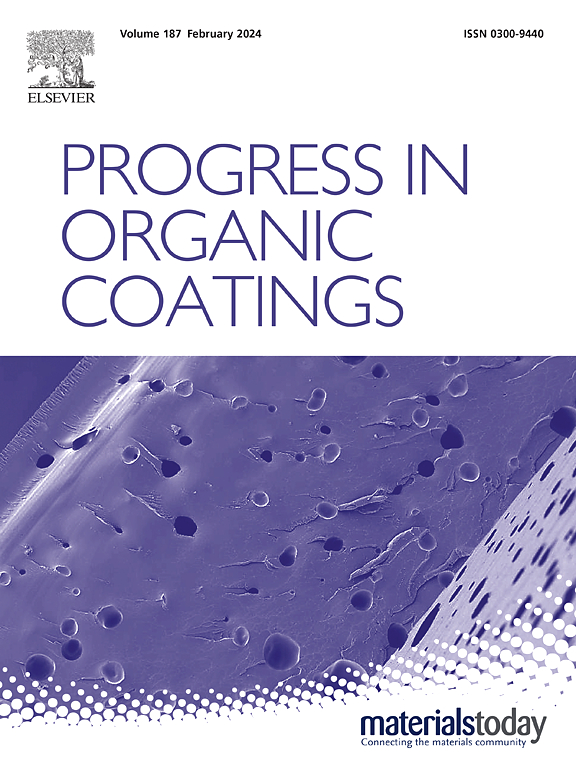电沉积聚四氟乙烯超疏水涂层:mgcl2介导的微纳结构多功能防冰性能
IF 7.3
2区 材料科学
Q1 CHEMISTRY, APPLIED
引用次数: 0
摘要
本研究通过调节氯化镁(MgCl2)浓度(0.04-0.20 g/L),优化了电沉积制备超疏水聚四氟乙烯(PTFE)涂层的方法。系统实验和机理分析表明,MgCl2具有控制微纳结构演化和增强界面稳定性的双重作用。经过300次胶带剥离、2000 mm线性磨损和60 min水射流冲击后,涂层仍保持超疏水性。XRD分析证实形成的氯氧镁水泥相(5mg (OH)2·MgCl2·8H2O)作为有效的粘结剂,提高了界面附着力和机械强度。Mg2+引起的电荷中和控制着电泳动力学:0.04 g/L时出现覆盖不足,而0.20 g/L时出现颗粒团聚。优化后的0.12 g/L浓度可实现高密度聚四氟乙烯沉积,稳定Cassie-Baxter状态,实现166.9°的水接触角和2°的滑动角。与裸铝相比,优化后的涂层冻结时间延长了47倍(278 s vs 6 s),冰的粘附强度降低了76.5% (38.3 kPa vs 163.3 kPa)。在釉霜(−3℃)和霜霜(−13℃)结冰条件下,它抑制了81.8 - 83.5%的积冰。动态冻雨模拟表明,即使在低温下,也能有效地防止过冷液滴滞留。这项工作促进了对离子浓度介导的结构工程的基本理解,并为开发极端气候下电力传输和航空航天应用中的节能防冰系统提供了实际的解决方案。本文章由计算机程序翻译,如有差异,请以英文原文为准。
Electrodeposition of PTFE superhydrophobic coatings: MgCl2-mediated micro-nano structuring for multifunctional anti-icing performance
This study develops an optimized electrodeposition method for fabricating superhydrophobic polytetrafluoroethylene (PTFE) coatings by regulating magnesium chloride (MgCl2) concentration (0.04–0.20 g/L). Systematic experiments and mechanism analysis reveal MgCl2 plays a dual role in controlling micro-nano structure evolution and enhancing interfacial stability. The coating maintains superhydrophobicity after 300 tape-peeling cycles, 2000 mm linear abrasion, and 60 min water jet impact. XRD analysis confirms the formation of magnesium oxychloride cement phase (5 Mg(OH)2·MgCl2·8H2O) acting as an effective binder to improve interfacial adhesion and mechanical strength. Charge neutralization induced by Mg2+ governs electrophoretic dynamics: insufficient coverage occurs at 0.04 g/L while particle agglomeration emerges at 0.20 g/L. The optimized 0.12 g/L concentration enables dense PTFE deposition and stabilizes Cassie-Baxter state, achieving a water contact angle of 166.9° with a sliding angle of 2°. Compared with bare aluminum, the optimal coating exhibits 47-fold delayed freezing time (278 s vs 6 s) and 76.5 % reduced ice adhesion strength (38.3 kPa vs 163.3 kPa). It suppresses 81.8–83.5 % ice accumulation under glaze (−3 °C) and rime (−13 °C) icing conditions. Dynamic freezing rain simulations demonstrate effective prevention of supercooled droplet retention even at low temperatures. This work advances fundamental understanding of ion concentration-mediated structural engineering and provides practical solutions for developing energy-efficient anti-icing systems in power transmission and aerospace applications under extreme climates.
求助全文
通过发布文献求助,成功后即可免费获取论文全文。
去求助
来源期刊

Progress in Organic Coatings
工程技术-材料科学:膜
CiteScore
11.40
自引率
15.20%
发文量
577
审稿时长
48 days
期刊介绍:
The aim of this international journal is to analyse and publicise the progress and current state of knowledge in the field of organic coatings and related materials. The Editors and the Editorial Board members will solicit both review and research papers from academic and industrial scientists who are actively engaged in research and development or, in the case of review papers, have extensive experience in the subject to be reviewed. Unsolicited manuscripts will be accepted if they meet the journal''s requirements. The journal publishes papers dealing with such subjects as:
• Chemical, physical and technological properties of organic coatings and related materials
• Problems and methods of preparation, manufacture and application of these materials
• Performance, testing and analysis.
 求助内容:
求助内容: 应助结果提醒方式:
应助结果提醒方式:


